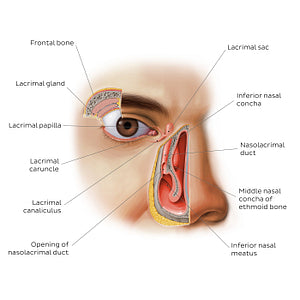Paul Kim
Lacrimal apparatus (English)
Lacrimal apparatus (English)
The lacrimal gland is located with a small fossa on the orbital surface of the frontal bone and is separated into a superior orbital part and an inferior palpebral part by the aponeurosis of the levator palpebrae superioris muscle. It produces lacrimal fluid, which is the aqueous component of the tear film and reaches the eye through 6-12 excretory ducts that open up into the superolateral aspect of the conjunctival sac between the eyelids and eyeball. Not visible in this image are small accessory lacrimal glands (of Krause) at the conjunctival fornix, which assist in the production of lacrimal fluid. The fluid then moves from lateral to medial across the eyeball, facilitated by the blinking of the eyelids, and collects in the lacrimal lake in the medial angle of the eye. This accumulation of fluid is drained by the lacrimal papillae, which conduct the fluid through the lacrimal canaliculi into the lacrimal sac, which continues inferiorly as the nasolacrimal duct opening on the lateral wall of the inferior nasal meatus.
Regular price
$7.56 USD
Regular price
Sale price
$7.56 USD
Unit price
per
Couldn't load pickup availability


#CE3822
#976C5A
#612D1F
#5B4437
#EB9689
#C8B5AB

